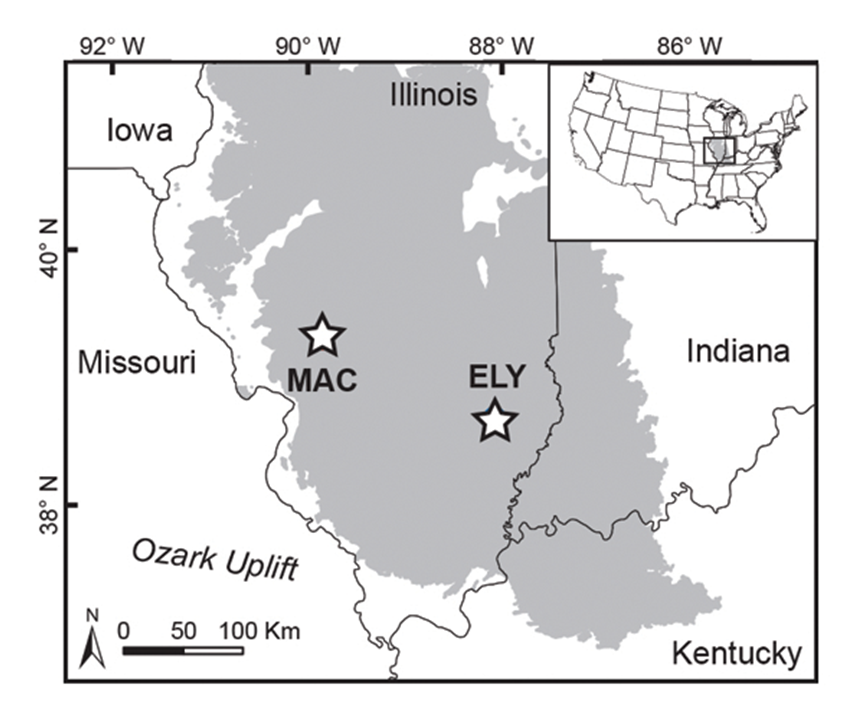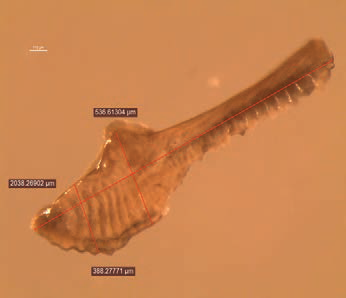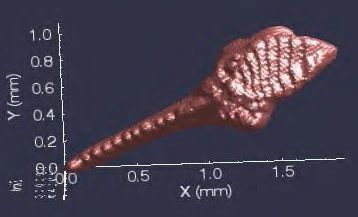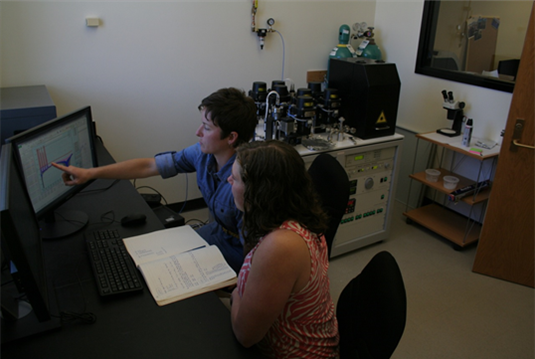Dr. Rebecca Flowers
 Department of Geological Sciences
Department of Geological Sciences
University of Colorado, Boulder
Quantitative Constraints on Thermal Histories in Carbonates and Marine Shales: Conodont (U‑Th)/He Thermochronology
Dr. Rebecca Flowers studies continental tectonics and landscape evolution and has a particular interest in linking erosional uplift histories with processes occurring deeper in the Earth’s crust and mantle. Her research uses (U-Th)/He thermochronology to decipher the thermal history of rocks. Temperatures increase with depth in the crust, so as a sedimentary rock is buried, it will heat up, but if it moves closer to the Earth’s surface due to removal of overlying rocks by erosion, then it will cool off. So by constraining the thermal history of a rock by (U-Th)/He dating one can also determine its burial and erosion history.
Discovering the thermal history of ancient continental rocks is also critical for understanding hydrocarbon formation. Heating of source rocks to temperatures in the “hydrocarbon window” of 60-120 ºC at burial depths of 1-3 km forms oil through the breakdown of organic matter in kerogens. Thus, determining the thermal history of sedimentary basins is important for effective hydrocarbon exploration.
Apatite is the mineral most commonly dated by (U-Th)/He thermochronology, and it can constrain thermal histories in the ~30-90 °C temperature range. The method is based on the radioactive decay of trace U and Th to He. Although apatite is abundant in granitoid, metamorphic, and coarse-clastic sedimentary rocks, many sedimentary rocks of interest to petroleum scientists tend to lack high-quality crystalline apatites needed for apatite (U-Th)/He (AHe) dating. Dr. Flowers’ PRF grant has enabled her to extend AHe dating to conodonts. Shales and limestones commonly contain these centimeter-sized biological apatite structures of marine chordates, ancestors of modern hagfish and lampreys. According to Dr. Flowers, the motivation for this study was to build on previous work in the scientific literature that conodont AHe thermochronology might have temperature sensitivity similar to crystalline apatite.
Conodonts are sufficiently abundant to allow age-determination and correlation of Cambrian through Triassic (490-200 million year old) sedimentary rocks. Previous research on thermal alteration of conodonts has been used to develop a Conodont Alteration Index (CAI), which correlates irreversible color changes of remnant organic matter within the microcrystalline hydroxyapatite matrix of these microfossils to the burial temperatures of ancient sediments. CAI values relate specific colors of conodonts to burial temperatures ranging from 50-600 ºC, but don’t give any information about the time of burial, or the thermal history of the conodont-bearing rocks.
Research by Dr. Flowers and her PhD student, Rachel Landman, revealed that conodonts from Illinois Basin sedimentary rocks yielded a subset of reproducible AHe dates that are consistent with CAI temperature estimates and local cooling histories based on other geologic information. A concern that traditional acid-based separation of conodonts from limestones could affect the dates by disturbing the U-Th/He systematics of samples led Dr. Flowers to investigate the use of electric-pulse disaggregation to remove conodonts from their sedimentary matrix. Examination of platforms by ultra-high resolution microcomputed tomography prior to AHe analysis also enabled calculation of more accurate alpha-ejection corrections to account for loss of Helium at the edges of apatite crystals. Ultimately, this study showed that platform conodont elements, especially those with higher U-Th, yielded the most-reproducible results. In contrast, bar and blade conodont element types yielded more dispersed dates that include anomalously-old results, which they interpret as a consequence of U-Th loss during open-system conodont behavior.
Her next step will be collaborating with a conodont paleontologist to characterize the best fossils for consistent and reproducible results, focusing on the best lithologies for dating, and then using samples from another sedimentary basin to further develop the potential of this methodology. According to Dr. Flowers, “If we successfully develop conodonts as a new thermochronometer, then this would become an important new tool to constrain thermal histories in sedimentary basins.” She also noted that “my PRF ‘starter grant’ was the key to recruit a graduate student, launch a research project, and to establish myself in the field. I would not have been able to pursue this new research direction without the support of my current (ND) grant.”
Dr. Flowers received a Bachelors’ degree in Geology from the College of William and Mary, and an M.S. in Geology from the University of Utah. Her doctoral studies in Geology and Geochemistry at the Massachusetts Institute of Technology were supported by an NSF Graduate Fellowship. After a post-doctoral fellowship at the California Institute of Technology, she joined the faculty of the University of Colorado, Boulder in 2007. Dr. Flowers was a Distinguished Lecturer of the Mineralogical Society of America in 2015-2016.
Grant #53525-ND8: Read Flower's Annual Report
 Illinois Basin
Illinois Basin Conodont
Conodont Conodont
Conodont Dr. Flowers at Augrabies Falls on the Orange River, South Africa, within the Augrabies Falls National Park (2013)
Dr. Flowers at Augrabies Falls on the Orange River, South Africa, within the Augrabies Falls National Park (2013) Students
Students










